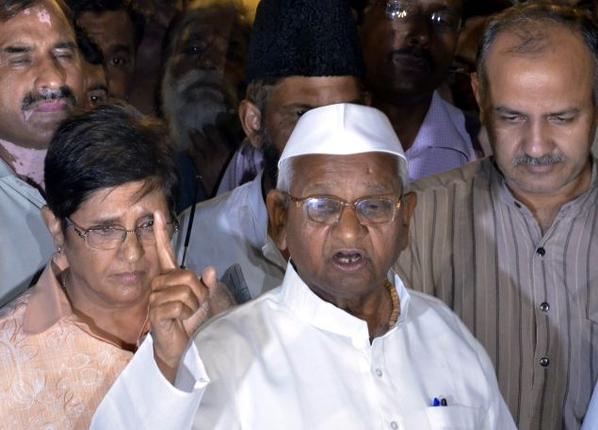
New Delhi, September 19: Team Anna on Wednesday suffered a vertical split with Anna Hazare and some top activists choosing to part ways with the Arvind Kejriwal-led group, opposing their plans to form a political party.
After a roller-coaster ride of 18 months in which they came together to run a high-steam anti-graft movement, the group led by Mr. Hazare had acrimonious discussions with Mr. Kejriwal and his supporters including Prashant Bushan and Shanti Bhushan on the issue of forming a political party.
Backed by activists including Kiran Bedi and Justice Santosh Hegde, Mr. Hazare told the other group during the nine-hour deliberations that they were free to form a political party but cannot use his name or photo for their campaign.
“It is unfortunate that the team has separated...I will not join any party or any group. I will not go for their campaign. I have told them not to use my photo or my name in their campaign. You fight on your own,” he told reporters in New Delhi.
Mr. Hazare refused to accept the survey done by India Against Corruption, which overwhelmingly favoured a political path, saying he does not agree with the exercise done through social networking sites. “My best wishes are with them (those taking political path). There is no harm in it. If they think that they can get majority in Parliament, it is good... The paths have been separated. Both of us have chosen our (separate paths).”
When pointed out that Mr. Kejriwal had earlier declared that he will not form any party if Mr. Hazare does not approve it, he said if that was the case, then the party should not be formed but “it is a good thing”.
The discussions saw a section alleging that Mr. Hazare was “exploited” by the Kejriwal group. It was countered by others saying “people in Delhi have made Anna what he is now“.
Reacting to the developments, Mr. Kejriwal tweeted, “Country is on sale. It is passing through very difficult phase. I will do everything possible for me to save my country.”
Ms. Bedi, who is opposed to forming of a political party, tweeted, “Anna finally distances himself from political option. Moves to strengthen the movement. May bring together anti-corruption movements.”
She told PTI that she did appeal to those members of the team who were very keen on political option to give the movement some more time.
“But it appears that they are convinced about their option. This finality by Anna was essential to dispel the mix up of the movement and the party politics,” she said.
Giriraj Kishore, an ex-Registrar of IIT Kanpur who attended the meeting, said the overall mood of the discussions was that the movement should remain united and should reach a fruitful conclusion.
“A section of those in meeting said Hazare was exploited by some people in the movement. But this is not true. If Anna has given his name to the movement, people here have made the Anna what he is now. They built the image of Anna,” he said.
Bollywood actor Anupam Kher, who attended the meeting, said in case one needs to fight corruption solidly, one “may have to fight elections”. He said there is no controversy but only deliberations.
During his interaction with the media, Mr. Hazare also expressed hope that government will be forced to pass a strong Lokpal Bill as elections are nearing and the government should be fearing it.
“They will be afraid of losing power. That time has come. I believe that they will have to bring the Lokpal Bill before elections. Now it is that they bring Lokpal or my death,” he said.





Comments
Add new comment